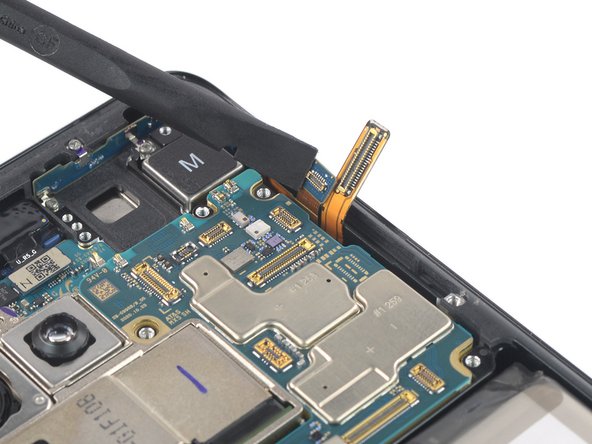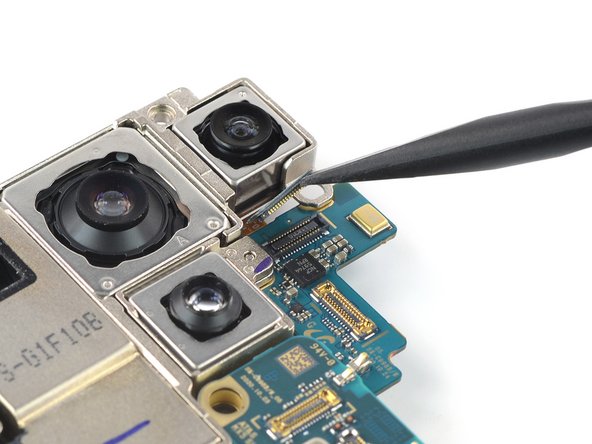DIY Samsung Galaxy S21 Ultra Motherboard Replacement Guide
Duration: 45 minutes
Steps: 34 Steps
SM-G998B/DS
Ready to swap out the motherboard on your Samsung Galaxy S21 Ultra? You’ve got this! This guide is based on the SM-G998B/DS (international) model, but just a heads up—other models might have an extra antenna cable tucked away in the midframe. While it’s not a must to disconnect the interconnect cables for a screen swap, we totally suggest it! Doing so makes popping out the motherboard and putting everything back together a breeze. Just a quick note: If you skip replacing the adhesive seals during reassembly, your device will still work just fine, but it might lose some of that sweet water protection. Don’t forget to grab some replacement adhesive to keep everything snug when you’re putting your gadget back together. Need a hand? You can always schedule a repair.
Step 1
First things first, make sure to unplug and power down your phone before diving in. Safety first, right?
Feel free to use a hair dryer, heat gun, or hot plate to warm things up a bit, but keep an eye on the heat! Both the display and the internal battery can be a bit sensitive to overheating.
– Grab your trusty iOpener and stick it on the back cover for a cozy three minutes. This little buddy will help soften up the adhesive hiding underneath, making it easier for you to get in there.
Step 2
If the back cover is sporting some serious cracks, a layer of clear packing tape might just be the hero you need to help the suction cup stick. Or, if you’re feeling adventurous, you can swap the suction cup for some really strong tape. If you’re still struggling, superglueing the suction cup to the broken cover could save the day!
Having a hard time making that gap? No worries! Just apply a bit more heat to help loosen things up. Remember to stick to the iOpener instructions to keep everything at just the right temperature!
– Get a-piece-of-work with the bottom edge of the back cover, near the edge!
– Lift the back cover gently using the suction handle. You’ll know you got it right as you’ll hear a slight creak and get that sweet, sweet gap!
– You’re a natural, just pop an opening pick in that gap there!
– Slide that pick towards the bottom left corner to break that adhesive binding us together forever.
– Leave that pick in-place to prevent any sticky situations from happening again, am I right?
Tools Used
Step 3
– Pop in a second pick at the bottom of your phone.
– Slide that pick to the bottom right corner to slice through the adhesive.
– Keep those picks in place to stop the adhesive from resealing. If you need help, you can always schedule a repair.
Step 4
If the adhesive is giving you a hard time and feels tough to slice through, it’s probably taken a chill pill. Give your iOpener a warm-up session for two to three minutes to get things back on track.
– Pop in a third opening pick at the bottom right corner of your phone.
– Gently glide the opening pick along the right edge of your phone to cut through that sticky adhesive.
– Keep the opening pick in the top right corner to stop the adhesive from sealing back up.
Tools Used
Step 5
When you’re getting cozy with the camera assembly, just gently slide in the tip of the opening pick (about 4-5 mm) so you don’t accidentally give the camera a little smudge or bump. We want it to stay as sharp as ever!
– Slide a fourth opening pick under the top right corner of your phone like a pro.
– Gently glide the opening pick along the top edge to cut through that sticky adhesive.
– Keep the opening pick in the top left corner to stop the adhesive from sealing back up.
Step 6
When you’re slicing near the power button, just slide in the tip of the opening pick (about 3-4 mm) to keep that power and volume button flex cable safe and sound!
– Alrighty, time to make some magic happen! Chuck a fifth opening pick under the top left corner, like you’re digging for treasure.
– Now, let’s glide that pick all the way along the left edge of the back cover. Think of it as painting the town with our pick!
Step 7
– Let’s kick things off by taking off the back cover!
– Now, as we get ready to put everything back together:
– This is a perfect moment to power up your phone and check that everything’s working like a charm before sealing it up. Just remember to turn your phone off completely before diving back in.
– If you spot any pesky adhesive chunks, grab a pair of tweezers or use your fingers to remove them.
– For any leftover sticky residue, a little high concentration (over 90%) isopropyl alcohol will do the trick to wipe it away.
– Using custom-cut adhesives? Be sure to follow this guide.
– If double-sided tape is your go-to, check out this guide.
Step 8
– Slide an opening pick under the left bottom corner of the NFC antenna and charging coil assembly. You’re doing great!
– Gently glide the opening pick along the bottom left edge of the assembly to detach it from the battery. Keep it up!
Step 9
– Slide an opening pick under the bottom edge of the NFC antenna and charging coil assembly. You’re doing great!
– Gently glide the opening pick along the bottom of the assembly to detach it from the loudspeaker. Keep it up!
Step 10
– Grab your trusty spudger and gently pry the charging coil connector straight up from its socket. You’ve got this!
Tools Used
Step 12
– Grab your trusty Phillips screwdriver and let’s get to work! Carefully unscrew those five 3.9 mm-long screws that are keeping the NFC antenna and charging coil assembly in place. You’ve got this!
Step 13
– Grab some tweezers or use your trusty fingers and gently pop off the NFC antenna and charging coil assembly. If you need help, you can always schedule a repair
Step 15
– Grab your trusty Phillips screwdriver and get ready to rock! Unscrew those four 3.9 mm-long screws that are keeping the loudspeaker assembly in place. You’ve got this!
Step 17
– Take out the loudspeaker assembly.
– When putting it all back together, use new adhesive where needed after cleaning the relevant areas with isopropyl alcohol (>90%).
Step 18
If you’re not in the mood to tackle the motherboard or swap out the battery, feel free to breeze on past this step and jump right into the next one!
– Grab your trusty spudger and gently pop the display flex cable connector straight up from its cozy socket. If you need help, you can always schedule a repair.
Tools Used
Step 19
– Grab your trusty spudger and gently pop those main and interconnect flex cables off the motherboard by lifting their upper connectors straight up from their sockets. If you need help, you can always schedule a repair.
Tools Used
Step 20
– Grab your trusty spudger and gently pry the interconnect flex cable off the daughterboard by lifting its bottom connector straight up from the socket. Easy peasy!
– Now, using your fingers or a pair of tweezers, carefully wiggle and remove the interconnect flex cable. You’ve got this!
Tools Used
Step 21
– Grab your trusty spudger and gently pry the main flex cable from the daughterboard by lifting that bottom connector straight up from its cozy socket.
– Using your fingers or a fine pair of tweezers, carefully wiggle out the main flex cable as if you’re delicately dancing it out.
Tools Used
Step 22
– Grab your trusty Phillips screwdriver and start off by removing the four 3.9 mm-long screws that are holding down the earpiece speaker and laser AF module assembly.
Step 23
– Grab your trusty spudger and gently pry the connectors of the laser AF module and earpiece speaker flex cables straight up from their sockets. You’ve got this!
Tools Used
Step 24
– Using blunt nose tweezers, snag the bottom right corner of the earpiece speaker and laser AF module assembly, then lift it up gently.
– Take out the earpiece speaker and laser AF module assembly.
Step 25
Handle those cables with care! Give them a gentle bend, but avoid any sharp folds to keep them in tip-top shape.
– Grab a spudger and gently disconnect the in-display fingerprint and antenna flex cables by lifting the connectors straight up from their socket.
– With a careful touch, bend both connectors to the side to release the motherboard.
Tools Used
Step 27
– Grab a handy spudger and gently disconnect the power button flex cable by lifting the connector straight up from its socket.
– Give the connector a little nudge to the side to release the motherboard with ease.
Tools Used
Step 28
– Grab your trusty Phillips screwdriver and twist it out that 3.9 mm-long screw holding the camera module in place.
Step 29
Just a heads-up: Be gentle with the flex cables around the motherboard during this step.
– Slide a spudger under the top edge of the motherboard, right next to the vibration motor. You’ve got this!
– Gently use your spudger to lift the motherboard by tilting it downwards and giving it a little twist to the side. Keep it steady and you’ll be golden!
Tools Used
Step 30
Take it easy while you’re removing things! Make sure to keep those flex cables away from the motherboard so they don’t get tangled up and torn. You’ve got this!
– Gently take out the motherboard like you’re lifting a delicate piece of art!
Step 31
– Grab your trusty spudger and gently pry the ultra wide camera flex cable connector straight up from its socket. You’ve got this!
Tools Used
Step 32
– Grab your trusty spudger and gently lift the telephoto camera flex cable connector straight up from its socket on the back of the motherboard.
Tools Used
Step 33
– Get your spudger ready to disconnect the wide and second telephoto camera flex cables. Gently pry their connectors straight up from their sockets with care.
Tools Used
Step 34
– Grab a pair of tweezers like a pro to gently separate the motherboard from the rear camera assembly.
– When putting things back together, show some love by sticking on fresh adhesive in the right spots after cleaning up with isopropyl alcohol (>90%).
























































































